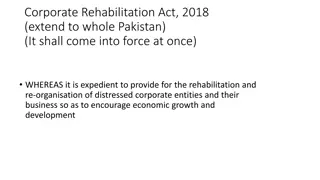Probation Identities in Transition: A Case Study
This case study explores the transformation of probation services through the lens of one CRC, focusing on the impact of policy changes, staff experiences, and organizational shifts. The research delves into the implications of transitioning from public to private sector employment, offering insights into the evolving landscape of probation services. Key findings shed light on the challenges and opportunities presented by the implementation of Transforming Rehabilitation strategies.
Download Presentation

Please find below an Image/Link to download the presentation.
The content on the website is provided AS IS for your information and personal use only. It may not be sold, licensed, or shared on other websites without obtaining consent from the author.If you encounter any issues during the download, it is possible that the publisher has removed the file from their server.
You are allowed to download the files provided on this website for personal or commercial use, subject to the condition that they are used lawfully. All files are the property of their respective owners.
The content on the website is provided AS IS for your information and personal use only. It may not be sold, licensed, or shared on other websites without obtaining consent from the author.
E N D
Presentation Transcript
Probation Identities in Transition: a case study in one CRC Gwen Robinson, University of Sheffield Lol Burke, Liverpool John Moores University Matthew Millings, Liverpool John Moores University European Society of Criminology Working Group on CSM School of Law, University of Sheffield, 1-2 June 2015
Contents Introducing Transforming Rehabilitation The research: a case study of TR in one CRC Main findings from phases 1-2 (March- October 2014) Forthcoming paper in British Journal of Criminology (online 19 May 2015)
Transforming Rehabilitation A policy/strategy with several strands, including: Splitting probation services via a logic of risk Former Probation Trusts dissolved New National Probation Service (to supervise high risk offenders) 21 new Community Rehabilitation Companies (CRCs) (to supervise medium and low risk offenders) The architect of TR: Chris Grayling, Justice Secretary (Sept 2012-May 2015)
Post-TR system of probation services Courts PUBLIC SECTOR National Probation Service (NPS) EM Community Rehabilitation Companies (CRCs) PRIVATE SECTOR providers
Slide with background picture Notes to this slide explain how Use sparingly, with no or few words Make sure text is legible on background
The research In-depth ethnographic case study of one CRC Focus on experience of CRC staff at all levels Process perspective: evolution over time Longitudinal component: mixed tracker sample Methods: observation; interviews; document analysis Research team: insiders and outsiders Independently funded by ESRC
Contextualising the study Other studies of worker migration from public to private sector employment in: criminal justice services (e.g. policing: White 2014; prisons: Ludlow 2014) other public services (e.g. NHS: Waring & Bishop 2011) Studies of organisational identities and role transitions (e.g. Beech 2011) Studies of probation occupational identities/cultures (e.g. Mawby & Worrall 2013; Robinson et al 2014)
TR timeline January 2013 Transforming Rehabilitation (TR) consultation published by MoJ May 2013 September 2013 TR strategy published by MoJ Target Operating Model published by MoJ August-November 2013 Decisions made about numbers and types of posts in NPS and CRCs November 2013 Bids to purchase CRCs submitted to MoJ November 2013-January 2014 Staff notified of allocation to NPS or CRC; appeals process March 2014 Research commences in one CRC Phase 1 of research March 2014 Probation Institute established 31 May 2014 Probation Trusts dissolved 1 June 2014 CRCs and NPS commence operations Phase 2 of research 29 October 2014 MoJ publishes information about preferred bidders for the 21 CRCs November 2014-January 2015 Preferred bidders commence discussions with CRC senior management Phase 3 of research 1 February 2015 New CRC owners commence operation/introduced to CRC staff Phase 4 of research 1 May 2015 Implementation of Offender Rehabilitation Act 2014 June 2015 Research fieldwork completed Phase 5 of research
Main findings Contracting out of probation services a unique case: creation of new organisational structures interstructural state of CRCs liminal status future ownership unknown (private? third sector? staff mutual?) protracted period of uncertainty An active and ongoing process of identity (re)construction CRC and staff members 5 key themes
Separation and loss move to CRC a painful/emotional process the old Trust as a family an unwanted divorce (from colleagues; from public sector) grieving process losses of colleagues and of valuable human capital to NPS; voluntary redundancies severing of relationships with service users (projected) loss of (former) local (brand) identity
Liminality and insecurity precarious employment (Standing 2011)- I feel less safe. I feel like the rug could be pulled out from under me at any time (PO) CRC staff as liminars in a holding tank - between socially constructed identities (Beech 2011) mixed reactions from anxious/fearful to excited/energised
Status anxiety CRC as new kid on the block fears about social invisibility of CRC (Turner 1967) - what s CRC? It doesn t say anything (PO) stigma or taint of (quasi-) private ownership second class probation deskilling via removal of roles (e.g. report writing) possible role redundancy for (qualified) probation officers (informal) preservation of probation label
Loyalty and trust attachments, loyalties and trust did not transfer unproblematically from the Trust to the CRC senior managers as self-appointed guardians of public service ethos/ probation values promotion of continuity but hard for them to preserve trustworthy identities loyalties of staff to: service users/ doing the work colleagues/teams but not to the CRC In terms of CRC, I m not sure because I don t know who the owners will be (PSO)
Liberation and innovation TR and the rhetoric of innovation some optimism around liberation from cumbersome systems, National Standards, high risk , etc. some examples of experimentation : creation of some new roles middle managers re-branded as leaders however, new freedoms were limited in the liminal space, and scary for some
Conclusion We are all on a personal journey in a situation not of our choosing (Senior Manager) 1 year on, those journeys are still ongoing Our study revealed an active and ongoing process of identity (re)construction - CRC and staff members Importance of local brand/identity typical or not? Next phase: reactions to new ownership and a new regional identity
References Beech, N. (2011) Liminality and the practices of identity reconstruction , Human Relations, 64, 2: 285-302. Ludlow, A. (2014) Transforming Rehabilitation: What lessons might be learned from prison privatisation? , European Journal of Probation, 6, 1: 67-81. Mawby, R.C. & Worrall, A. (2013) Doing Probation Work: Identity in a criminal justice occupation. Abingdon: Routledge. Robinson, G., Priede, C., Farrall, S., Shapland, J. & McNeill, F. (2014) Understanding quality in probation practice: Frontline perspectives in England & Wales , Criminology and Criminal Justice, 14, 2: 123-142. Standing, G. (2011) The Precariat: The New Dangerous Class. London: Bloomsbury. Turner, V. (1967) The Forest of Symbols: Aspects of Ndembu Rituals, Ithaca, NY: Cornell University Press. Waring, J. & Bishop, S. (2011) Healthcare identities at the crossroads of service modernisation: The transfer of NHS clinicians to the independent sector? , Sociology of Health and Illness, 33, 5: 661-76. White, A. (2014) Post-crisis policing and public-private partnerships: The case of Lincolnshire Police and G4S , British Journal of Criminology, 54: 1002-1022.























